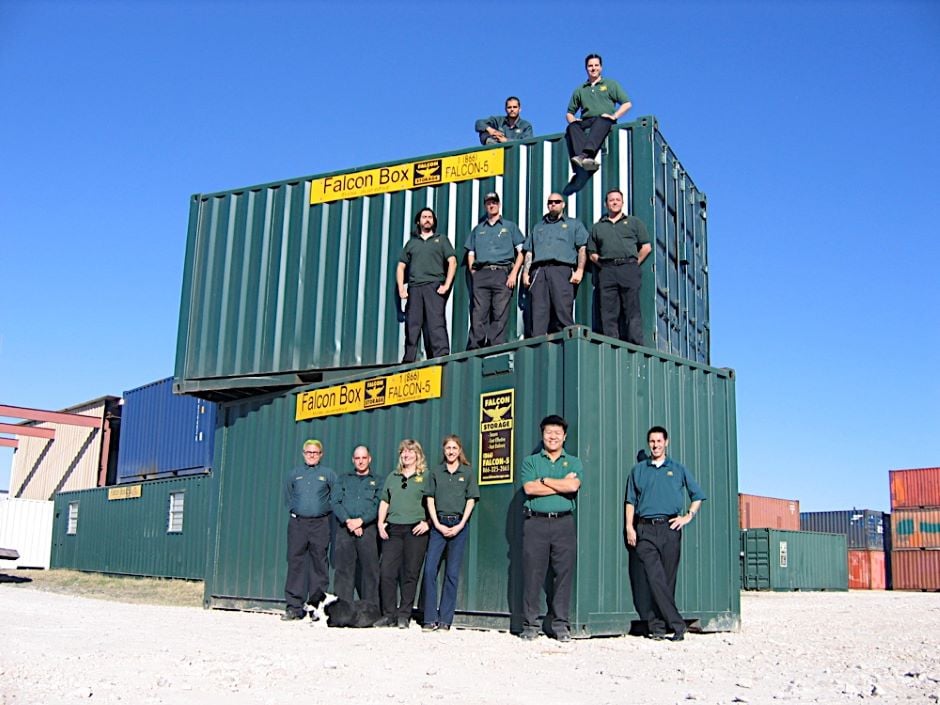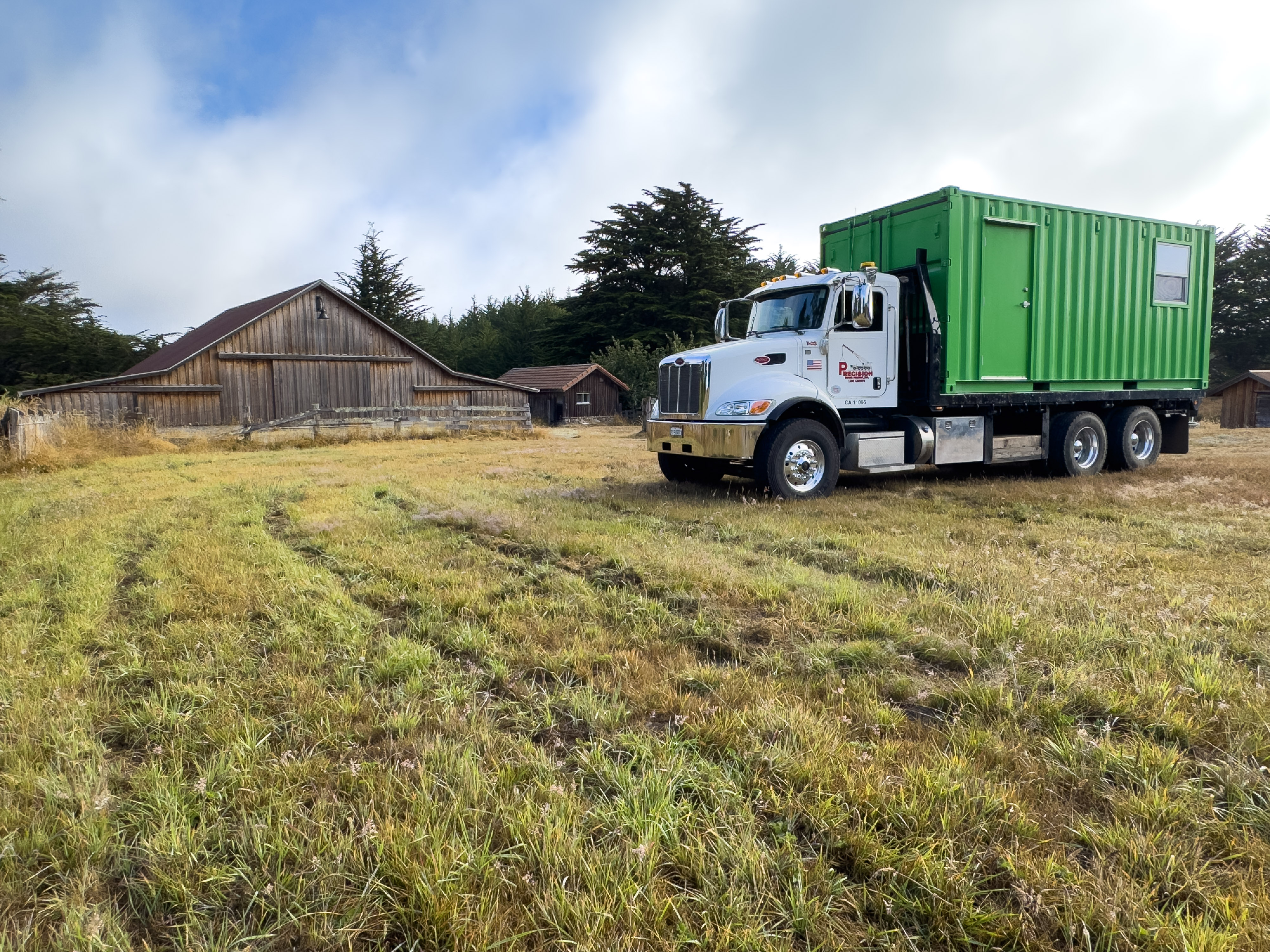Solar Power Battery Energy Storage System Design (BESS): Protecting & Managing with Shipping Container Structures
 Becca Hubert | Jun 12, 2024
Becca Hubert | Jun 12, 2024

Solar panels are an increasingly common sight on homes, businesses, and expansive solar farms. But where does all of this abundant, renewable energy go?
It’s necessary not just to capture this resource, but to adequately store it as well. Unlike oil or natural gas extracted and stored in tanks or underground, renewable energy like solar power requires different storage means. A common solution is to send excess power back into the grid. But there’s another, more efficient alternative: the battery energy storage system, or BESS.
What Is a Battery Energy Storage System?
A battery energy storage system stores renewable energy, like solar power, in rechargeable batteries. This stored energy can be used later to provide electricity when needed, like during power outages or periods of high demand. Its reliability and energy efficiency make the BESS design important for the future of renewable energy.
Battery Energy Storage System Design
A BESS is a complex device with intricate technical components. These include battery cells, typically lithium-ion, and inverters that transform direct current (DC) to alternating current (AC). There are multiple control systems, including battery management, power conversion, fire safety, and more.
These systems come in a range of sizes. You might have a small BESS mounted in your garage to charge your electric vehicle. A residential BESS that powers your home in an outage might be the size of a mini fridge. But larger applications, like a solar farm, require much larger systems. And the bigger the BESS, the bigger the challenge to enclose it.

Some organizations opt for custom system enclosures for their large-scale operations. However, the design and implementation of these systems can be complex, costly, and time-consuming.
- Time - From the drawing stage to prototyping and production, unique and highly customized industrial enclosures are a substantial time investment.
- Scalability - Larger applications require multiple battery energy storage systems. Once a custom enclosure is designed and prototyped, you must source a manufacturer that can produce them at the scale required.
- Expense - Between the cost of time to implementation and production fees, you’re looking at a sizable price tag.
Much to our delight, champions of renewable energy are turning toward our favorite industrial problem solver: the shipping container.

Shipping Containers as BESS Enclosures
The battery energy storage market was estimated to be around $2.8 billion in 2022. By 2032, estimates are around $49.2 billion. It’s safe to assume the demand for BESS enclosures will grow as well. Shipping containers are stepping in as the practical, available, and modifiable solution to the industry’s growing demand.
Size
20 and 40-foot shipping containers are the ideal size for all of the interior components of a BESS. Depending on the configuration, there could even be room for a technician workspace.
Portable
The ability to relocate a BESS is a desirable feature. They’re a necessary resource in cases of disaster relief, emergencies, and off-grid operations.
Customizable
The proven customizability of shipping containers is another reason energy leaders are considering containers. The same modifications Falcon deploys on an everyday basis are the same ones that transform a container into a BESS enclosure.
- Climate control - The internal components of a BESS are highly sensitive and must be stored in a controlled climate. Container modifications accommodate this need with heavy-duty HVAC systems, supplemental ventilation, as well as spray foam insulation applied on all six sides to combat humidity.
- Custom openings - A BESS enclosure requires more accessibility to the interior than standard container cargo doors allow. With the right reinforced openings, however, BESS components become easy to access for routine maintenance. This could look like industrial doors along the side of the container, or roll-up doors to reveal panels of battery packs.
- Interior modifications - The interior needs of a BESS enclosure call for modifications similar to other industrial enclosures Falcon has created. Built-in shelving, partitions, extra electrical outlets, and firewalls are just a few examples.
Environmentally Conscious
A repurposed one-trip shipping container, like the ones Falcon modifies, is a more sustainable and efficient alternative to many custom-built enclosures. With roughly 17 million in circulation today, reusing them minimizes waste and consumes less energy.
Battery storage for solar power is essential for the future of renewable energy efforts. As the market continues to grow, we expect the adoption of modified shipping container BESS enclosures to grow as well. Containers are an elegant solution to the logistical and financial challenges of the battery storage industry. More importantly, they contribute toward a sustainable and resilient future of cleaner energy.
Want to learn more about a custom container battery storage system enclosure? Let’s talk! Reach out to our team at 512-131-1010 or email us at Sales@FalconStructures.com.
SUBSCRIBE
- Shipping Container Modifications
- How-Tos
- Workspace
- Commercial Construction
- Multi-Container Buildings
- Storage Solutions
- Industrial Enclosures
- Bathrooms & Locker Rooms
- Oil & Gas
- Climate Control
- Green Building
- Living Space
- Industry Insight
- Military & Training Facilities
- Water Treatment Solutions
- Energy
THINK INSIDE THE BOX®
WITH OUR BLOG
Get everything from shipping container basics, to detailed how-tos and industry news in our weekly blog. Stay inspired and subscribe!
RELATED BLOGS
 Solar Power Battery Energy Storage System Design (BESS): Protecting & Managing with Shipping Container Structures featured image" srcset="https://www.falconstructures.com/hs-fs/hubfs/5.%20images/b.%20blog%20page/Employees%20on%20Containers-1.jpg?width=360&name=Employees%20on%20Containers-1.jpg 360w,https://www.falconstructures.com/hs-fs/hubfs/5.%20images/b.%20blog%20page/Employees%20on%20Containers-1.jpg?width=480&name=Employees%20on%20Containers-1.jpg 480w,https://www.falconstructures.com/hs-fs/hubfs/5.%20images/b.%20blog%20page/Employees%20on%20Containers-1.jpg?width=720&name=Employees%20on%20Containers-1.jpg 720w,https://www.falconstructures.com/hs-fs/hubfs/5.%20images/b.%20blog%20page/Employees%20on%20Containers-1.jpg?width=768&name=Employees%20on%20Containers-1.jpg 768w,https://www.falconstructures.com/hs-fs/hubfs/5.%20images/b.%20blog%20page/Employees%20on%20Containers-1.jpg?width=1350&name=Employees%20on%20Containers-1.jpg 1350w,https://www.falconstructures.com/hs-fs/hubfs/5.%20images/b.%20blog%20page/Employees%20on%20Containers-1.jpg?width=1440&name=Employees%20on%20Containers-1.jpg 1440w,https://www.falconstructures.com/hs-fs/hubfs/5.%20images/b.%20blog%20page/Employees%20on%20Containers-1.jpg?width=1920&name=Employees%20on%20Containers-1.jpg 1920w,https://www.falconstructures.com/hs-fs/hubfs/5.%20images/b.%20blog%20page/Employees%20on%20Containers-1.jpg?width=2278&name=Employees%20on%20Containers-1.jpg 2278w"
loading="lazy">
Solar Power Battery Energy Storage System Design (BESS): Protecting & Managing with Shipping Container Structures featured image" srcset="https://www.falconstructures.com/hs-fs/hubfs/5.%20images/b.%20blog%20page/Employees%20on%20Containers-1.jpg?width=360&name=Employees%20on%20Containers-1.jpg 360w,https://www.falconstructures.com/hs-fs/hubfs/5.%20images/b.%20blog%20page/Employees%20on%20Containers-1.jpg?width=480&name=Employees%20on%20Containers-1.jpg 480w,https://www.falconstructures.com/hs-fs/hubfs/5.%20images/b.%20blog%20page/Employees%20on%20Containers-1.jpg?width=720&name=Employees%20on%20Containers-1.jpg 720w,https://www.falconstructures.com/hs-fs/hubfs/5.%20images/b.%20blog%20page/Employees%20on%20Containers-1.jpg?width=768&name=Employees%20on%20Containers-1.jpg 768w,https://www.falconstructures.com/hs-fs/hubfs/5.%20images/b.%20blog%20page/Employees%20on%20Containers-1.jpg?width=1350&name=Employees%20on%20Containers-1.jpg 1350w,https://www.falconstructures.com/hs-fs/hubfs/5.%20images/b.%20blog%20page/Employees%20on%20Containers-1.jpg?width=1440&name=Employees%20on%20Containers-1.jpg 1440w,https://www.falconstructures.com/hs-fs/hubfs/5.%20images/b.%20blog%20page/Employees%20on%20Containers-1.jpg?width=1920&name=Employees%20on%20Containers-1.jpg 1920w,https://www.falconstructures.com/hs-fs/hubfs/5.%20images/b.%20blog%20page/Employees%20on%20Containers-1.jpg?width=2278&name=Employees%20on%20Containers-1.jpg 2278w"
loading="lazy">
20 Years of Falcon Structures: A Look Back and a Celebration
Becca Hubert | Nov 29, 2023 | 5 min read
READ MORE
 Solar Power Battery Energy Storage System Design (BESS): Protecting & Managing with Shipping Container Structures featured image" srcset="https://www.falconstructures.com/hs-fs/hubfs/5.%20images/b.%20blog%20page/Serv%20feature%20rsz.jpg?width=360&name=Serv%20feature%20rsz.jpg 360w,https://www.falconstructures.com/hs-fs/hubfs/5.%20images/b.%20blog%20page/Serv%20feature%20rsz.jpg?width=480&name=Serv%20feature%20rsz.jpg 480w,https://www.falconstructures.com/hs-fs/hubfs/5.%20images/b.%20blog%20page/Serv%20feature%20rsz.jpg?width=720&name=Serv%20feature%20rsz.jpg 720w,https://www.falconstructures.com/hs-fs/hubfs/5.%20images/b.%20blog%20page/Serv%20feature%20rsz.jpg?width=768&name=Serv%20feature%20rsz.jpg 768w,https://www.falconstructures.com/hs-fs/hubfs/5.%20images/b.%20blog%20page/Serv%20feature%20rsz.jpg?width=1350&name=Serv%20feature%20rsz.jpg 1350w,https://www.falconstructures.com/hs-fs/hubfs/5.%20images/b.%20blog%20page/Serv%20feature%20rsz.jpg?width=1440&name=Serv%20feature%20rsz.jpg 1440w,https://www.falconstructures.com/hs-fs/hubfs/5.%20images/b.%20blog%20page/Serv%20feature%20rsz.jpg?width=1920&name=Serv%20feature%20rsz.jpg 1920w,https://www.falconstructures.com/hs-fs/hubfs/5.%20images/b.%20blog%20page/Serv%20feature%20rsz.jpg?width=2278&name=Serv%20feature%20rsz.jpg 2278w"
loading="lazy">
Solar Power Battery Energy Storage System Design (BESS): Protecting & Managing with Shipping Container Structures featured image" srcset="https://www.falconstructures.com/hs-fs/hubfs/5.%20images/b.%20blog%20page/Serv%20feature%20rsz.jpg?width=360&name=Serv%20feature%20rsz.jpg 360w,https://www.falconstructures.com/hs-fs/hubfs/5.%20images/b.%20blog%20page/Serv%20feature%20rsz.jpg?width=480&name=Serv%20feature%20rsz.jpg 480w,https://www.falconstructures.com/hs-fs/hubfs/5.%20images/b.%20blog%20page/Serv%20feature%20rsz.jpg?width=720&name=Serv%20feature%20rsz.jpg 720w,https://www.falconstructures.com/hs-fs/hubfs/5.%20images/b.%20blog%20page/Serv%20feature%20rsz.jpg?width=768&name=Serv%20feature%20rsz.jpg 768w,https://www.falconstructures.com/hs-fs/hubfs/5.%20images/b.%20blog%20page/Serv%20feature%20rsz.jpg?width=1350&name=Serv%20feature%20rsz.jpg 1350w,https://www.falconstructures.com/hs-fs/hubfs/5.%20images/b.%20blog%20page/Serv%20feature%20rsz.jpg?width=1440&name=Serv%20feature%20rsz.jpg 1440w,https://www.falconstructures.com/hs-fs/hubfs/5.%20images/b.%20blog%20page/Serv%20feature%20rsz.jpg?width=1920&name=Serv%20feature%20rsz.jpg 1920w,https://www.falconstructures.com/hs-fs/hubfs/5.%20images/b.%20blog%20page/Serv%20feature%20rsz.jpg?width=2278&name=Serv%20feature%20rsz.jpg 2278w"
loading="lazy">
SERV Shipping Container Venue Brought to Life by Falcon Structures
Becca Hubert | Oct 4, 2023 | 5 min read
READ MORE
 Solar Power Battery Energy Storage System Design (BESS): Protecting & Managing with Shipping Container Structures featured image" srcset="https://www.falconstructures.com/hs-fs/hubfs/IMG_3076.jpg?width=360&name=IMG_3076.jpg 360w,https://www.falconstructures.com/hs-fs/hubfs/IMG_3076.jpg?width=480&name=IMG_3076.jpg 480w,https://www.falconstructures.com/hs-fs/hubfs/IMG_3076.jpg?width=720&name=IMG_3076.jpg 720w,https://www.falconstructures.com/hs-fs/hubfs/IMG_3076.jpg?width=768&name=IMG_3076.jpg 768w,https://www.falconstructures.com/hs-fs/hubfs/IMG_3076.jpg?width=1350&name=IMG_3076.jpg 1350w,https://www.falconstructures.com/hs-fs/hubfs/IMG_3076.jpg?width=1440&name=IMG_3076.jpg 1440w,https://www.falconstructures.com/hs-fs/hubfs/IMG_3076.jpg?width=1920&name=IMG_3076.jpg 1920w,https://www.falconstructures.com/hs-fs/hubfs/IMG_3076.jpg?width=2278&name=IMG_3076.jpg 2278w"
loading="lazy">
Solar Power Battery Energy Storage System Design (BESS): Protecting & Managing with Shipping Container Structures featured image" srcset="https://www.falconstructures.com/hs-fs/hubfs/IMG_3076.jpg?width=360&name=IMG_3076.jpg 360w,https://www.falconstructures.com/hs-fs/hubfs/IMG_3076.jpg?width=480&name=IMG_3076.jpg 480w,https://www.falconstructures.com/hs-fs/hubfs/IMG_3076.jpg?width=720&name=IMG_3076.jpg 720w,https://www.falconstructures.com/hs-fs/hubfs/IMG_3076.jpg?width=768&name=IMG_3076.jpg 768w,https://www.falconstructures.com/hs-fs/hubfs/IMG_3076.jpg?width=1350&name=IMG_3076.jpg 1350w,https://www.falconstructures.com/hs-fs/hubfs/IMG_3076.jpg?width=1440&name=IMG_3076.jpg 1440w,https://www.falconstructures.com/hs-fs/hubfs/IMG_3076.jpg?width=1920&name=IMG_3076.jpg 1920w,https://www.falconstructures.com/hs-fs/hubfs/IMG_3076.jpg?width=2278&name=IMG_3076.jpg 2278w"
loading="lazy">
Shipping Container Solution for Rare Book Storage
Becca Hubert | Dec 22, 2023 | 4 min read
READ MORE
